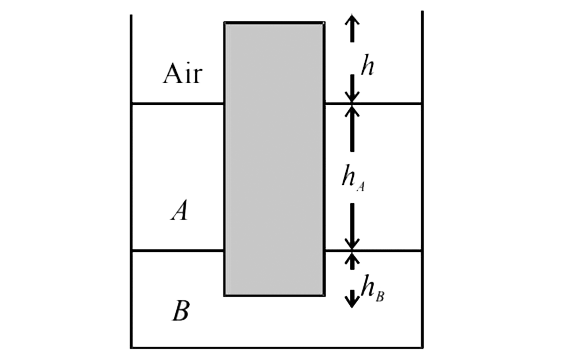Two immiscible of densities 2.5g/cm3 and 0.8g/cm3 are taken in the ratio of their masses as 2:3 respectively find the average density of the liquid conbination.
Let masses be 2M and 3M then
V=V1+V2=(2M2.5+3M0.8)cm3
Total mass =2M+3M=5M
Therefore, the average density
ρav=5Mv=5M2M2.5+3M0.8=522.5+30.8
=109.1g/cm3=1.09g/cm3
Topper's Solved these Questions
- BOOK - MOTIONCHAPTER - HYDROSTATIC, FLUID MECHANICS & VISCOSITYEXERCISE - QUESTIONS FOR PRACTICE6videos
HYDROSTATIC, FLUID MECHANICS & VISCOSITY
- BOOK - MOTIONCHAPTER - HYDROSTATIC, FLUID MECHANICS & VISCOSITYEXERCISE - EXERCISE-1 (OBJECTIVE PROBLEMS)100videos
HYDROSTATIC, FLUID MECHANICS & VISCOSITY
- BOOK - MOTIONCHAPTER - HEAT-2 EXERCISE - EXERCISE-4 (LEVEL-II)30videos
HEAT-2
- BOOK - MOTIONCHAPTER - KINEMATICSEXERCISE - EXERCISE 4 PREVIOUS YEAR (LEVEL 2)6videos
KINEMATICS
Similar Questions
A container is filled with two immiscible liquids A and B of densities 2 g cm−3and3 g cm−3 , respectively. A wooden cube of side 1 cm floats on the surface of liquid A such that one-fourth of its total length is immersed in this liquid (A).
Now, the wooden cube is completely immersed in liquid A by suspending a sinker of volume 10 cm3 which is completely submerged in liquid B. Determine the weight of the sinker.View SolutionThe density of wood is 0.65 g/cm3 . The density in SI system is
View Solution
Knowledge Check
- Question 1 - Select One
Two discs one of density 7.2g/cm3 and the other of density 8.9g/cm3 are of same mass and thickness. Their moments of inertia are in the ratio
A8.97.2B7.28.9C(8.9×7.2):1D1:(8.9×7.2) - Question 2 - Select One
Two discs one of density 7.2 g/cm3 and the other of density 8.9 g/cm3 are of same mass and thickness. Their moments of inertia are in the ratio
A8.9:7.2B7.2:8.9C(8.9×7.2):1D1:(8.9×7.2) - Question 3 - Select One
Two discs of same mass and same thickness have densities as 17g/cm3 and 51g/cm3. The ratio of their moment of inertia about their central axes is
A13B23C31D32
An object floats in three immiscible liquids A, B and C of densities 3g cm−3,2g cm−3, respectively as shown in the figure. When the object is placed in the liquids, the levels of liquid A, B and C rise by 3 cm, 5 cm and 8 cm, respectively. The areas of cross-sections of the container and the object are 10 cm2and5cm2, respectively. Calculate the density of the object.
 View Solution
View SolutionA body of density 2.5g/cm3 is let free in a liquid of density 1.25g/cm3 . The downward acceleration of the of the body while sinking in the liquid is . _______
View SolutionTwo identical tanks contain water and a liquid of density 0.8gcm−3. Pressure exerted by the liquid is equal to the pressure due to water column of 50 cm. Find the height of the liquid column in the tank ?
View SolutionA physics student took a solid sphere of density 2 g cm−3 and radius 3.5 cm and applied a force on the sphere. If an acceleration fo 1.5 cms−2 is produced in it, find the amount of force applied on it.
View SolutionA uniform solid cylinder of density 0.8g/cm3 floats in equilibrium in a combination of two non-mixing liquids A and B with its axis vertical.
The densities of the liquids A and B are 0.7g/cm3 and 1.2g/cm3, respectively. The height of liquid A is hA=1.2cm. The length of the part of the cylinder immersed in liquid B is hB=0.8cm.

(a) Find the total force exerted by liquid A on the cylinder.
(b) Find h, the length of the part of the cylinder in air.
(c) The cylinder is depressed in such a way that its top surface is just below the upper surface of liquid A and is then released. Find the acceleration of the cylinder immediately after it is released.View Solution

